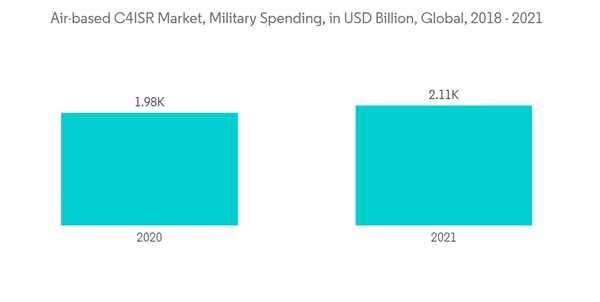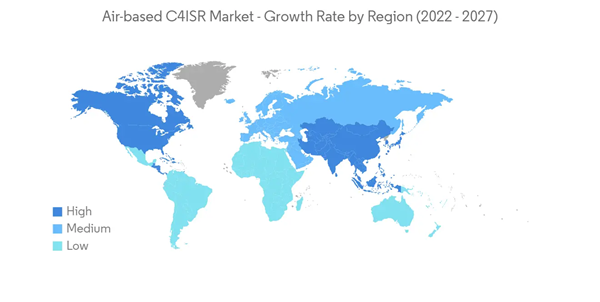The Air-based C4ISR Market size is estimated at USD 3.34 billion in 2024, and is expected to reach USD 3.69 billion by 2029, growing at a CAGR of 1.98% during the forecast period (2024-2029).
Despite the COVID-19 pandemic hitting the global economy severely, the impact of the same is not felt on the global military expenditure, which continued to increase in 2020 and 2021. The global military expenditure reached a total of USD 2.113 trillion in 2021, increasing by about 0.7% compared to 2020. Such high expenditure indicates the negligible impact the COVID-19 pandemic had on defense systems development and procurements. The growth in military spending is expected to drive the air-based C4ISR market in the coming year.
The increasing political and geographical tensions around the world are propelling the demand for airborne C4ISR systems. The rapid growth in demand for unmanned aerial vehicles (UAVs), electronic support/countermeasures (ESM/ECM), airborne C2, advanced tactical air reconnaissance system, and airborne warning and control systems (AWACS) to enhance signal awareness and survivability is driving the growth of the air-based C4ISR market.
A majority of the demand for air-based C4ISR systems is anticipated to be generated in the Asia-Pacific region during the forecast period, due to factors, like modernization plans and an increase in the threat perception of countries.
Uncertainties in territorial rights, political tensions, and the quest for universal dominance among the military powerhouses are among the major causes disturbing the geopolitical scenario. In this regard, the most common reaction of the governments is to increase their military spending, to improve security in their respective countries.
Despite the economic impact of the COVID-19 pandemic, global defense expenditure continued to increase in 2020 and 2021. According to SIPRI, the global military expenditure in 2021 rose to USD 2113 billion, an increase of 0.7% in from 2020. billion. Global spending in 2021 was 12% higher than in 2012. The five largest military spenders in 2021 were the United States, China, India, the United Kingdom, and Russia, which together accounted for 62% of world military spending.
As the threats for the countries become higher, enhancing the militaries' C4ISR capabilities becomes important for every country. In this regard, several military programs are currently underway to effectively upgrade the C4ISR capabilities of various countries. To facilitate these programs, countries are investing huge amounts into the enhancement of such capabilities, either through indigenous development or through procurement from global vendors. These investments are further driven by the growth in defense expenditures.
In recent years, countries in these regions have placed orders for newer generation platforms and equipment that incorporate C4ISR systems whereas several such development programs are also underway. These programs are expected to run during the forecast period.
The development and procurement of such platforms and equipment demands huge defense spending from the countries, as the cost of the systems is immense. Thus, the growth in defense spending is expected to drive the growth of the market in the coming years.
The increasing technology and electronic warfare have been driving the demand for technologies to effectively tackle electronic warfare. In line with this, new developments have been occurring in the army, to keep up with global technology. For instance, In March 2022, the Defence Ministry of India signed a partnership with BEL to supply an Advanced Electronic Warfare suite for the Indian Air Force fighter jets. The contract was signed between the Ministry of Defense and Bharat Electronics Limited (BEL), with an estimated value of INR 1993 Crore.
In efforts to increase communications technology for military purposes, south Korea has been investing in upgrading its existing technologies. As a result, new contracts and partnerships have been observed, to cater to the demand for military-grade communications. For instance,
In September 2021, Hanwha Systems and LIG Nex1 have announced that they have secured contracts from South Korea's Defense Acquisition Program Administration (DAPA) linked to ANASIS-II, the country's first dedicated military communications satellite. Hanwha Systems stated that they was awarded a KRW360 billion (USD307 million) contract to both establish a network control system and manufacture portable ground terminals by 2024 linked to the ANASIS-II satellite system, which launched into space in July 2020.
Such developments are expected to drive the market towards significant growth rates during the forecast period.
This product will be delivered within 2 business days.
Despite the COVID-19 pandemic hitting the global economy severely, the impact of the same is not felt on the global military expenditure, which continued to increase in 2020 and 2021. The global military expenditure reached a total of USD 2.113 trillion in 2021, increasing by about 0.7% compared to 2020. Such high expenditure indicates the negligible impact the COVID-19 pandemic had on defense systems development and procurements. The growth in military spending is expected to drive the air-based C4ISR market in the coming year.
The increasing political and geographical tensions around the world are propelling the demand for airborne C4ISR systems. The rapid growth in demand for unmanned aerial vehicles (UAVs), electronic support/countermeasures (ESM/ECM), airborne C2, advanced tactical air reconnaissance system, and airborne warning and control systems (AWACS) to enhance signal awareness and survivability is driving the growth of the air-based C4ISR market.
A majority of the demand for air-based C4ISR systems is anticipated to be generated in the Asia-Pacific region during the forecast period, due to factors, like modernization plans and an increase in the threat perception of countries.
Air-based C4ISR Market Trends
Growth in the Global Defense Expenditure
Owing to profound changes in the international strategic landscape, the configuration of international security systems has been undermined by the growing hegemonism, unilateralism, and power politics, which fueled several ongoing global conflicts.Uncertainties in territorial rights, political tensions, and the quest for universal dominance among the military powerhouses are among the major causes disturbing the geopolitical scenario. In this regard, the most common reaction of the governments is to increase their military spending, to improve security in their respective countries.
Despite the economic impact of the COVID-19 pandemic, global defense expenditure continued to increase in 2020 and 2021. According to SIPRI, the global military expenditure in 2021 rose to USD 2113 billion, an increase of 0.7% in from 2020. billion. Global spending in 2021 was 12% higher than in 2012. The five largest military spenders in 2021 were the United States, China, India, the United Kingdom, and Russia, which together accounted for 62% of world military spending.
As the threats for the countries become higher, enhancing the militaries' C4ISR capabilities becomes important for every country. In this regard, several military programs are currently underway to effectively upgrade the C4ISR capabilities of various countries. To facilitate these programs, countries are investing huge amounts into the enhancement of such capabilities, either through indigenous development or through procurement from global vendors. These investments are further driven by the growth in defense expenditures.
In recent years, countries in these regions have placed orders for newer generation platforms and equipment that incorporate C4ISR systems whereas several such development programs are also underway. These programs are expected to run during the forecast period.
The development and procurement of such platforms and equipment demands huge defense spending from the countries, as the cost of the systems is immense. Thus, the growth in defense spending is expected to drive the growth of the market in the coming years.
The Asia-Pacific region to Register Highest Growth During the Forecast Period
The Asia-Pacific region is expected to witness the highest growth rate as compared to the other regions, due to the presence of high military spending countries, such as China, India, and Japan. With the presence of geopolitical tensions in the land and sea borders in multiple countries, the procurement of C4ISR is likely to increase across the region. Forced modernization efforts across the Asia-Pacific region are also expected to increase the procurement of C4ISR systems. China and India are taking huge strides toward strengthening the capabilities of their armed forces and are among the top five defense-spending countries in the world.The increasing technology and electronic warfare have been driving the demand for technologies to effectively tackle electronic warfare. In line with this, new developments have been occurring in the army, to keep up with global technology. For instance, In March 2022, the Defence Ministry of India signed a partnership with BEL to supply an Advanced Electronic Warfare suite for the Indian Air Force fighter jets. The contract was signed between the Ministry of Defense and Bharat Electronics Limited (BEL), with an estimated value of INR 1993 Crore.
In efforts to increase communications technology for military purposes, south Korea has been investing in upgrading its existing technologies. As a result, new contracts and partnerships have been observed, to cater to the demand for military-grade communications. For instance,
In September 2021, Hanwha Systems and LIG Nex1 have announced that they have secured contracts from South Korea's Defense Acquisition Program Administration (DAPA) linked to ANASIS-II, the country's first dedicated military communications satellite. Hanwha Systems stated that they was awarded a KRW360 billion (USD307 million) contract to both establish a network control system and manufacture portable ground terminals by 2024 linked to the ANASIS-II satellite system, which launched into space in July 2020.
Such developments are expected to drive the market towards significant growth rates during the forecast period.
Air-based C4ISR Industry Overview
The prominent players in the air-based C4ISR market are Lockheed Martin Corporation, the Boeing Company, BAE Systems PLC, L3Harris Technologies Inc., Lockheed Martin Corporation, and Elbit Systems Ltd. However, there are many manufacturers that provide C4ISR solutions for air, land, and sea platforms. The regional manufacturers are gradually growing their presence in the market due to the support of their governments and partnerships with global players. Technological advancement in C4ISR systems and the demand for multi-functional systems are propelling the investments of manufacturers in the research and development of cost-effective solutions. For instance, a prototype of a rotary-wing UAV was unveiled by Hindustan Aeronautics Limited (HAL), In May 2021, Aeronautics introduced its Orbiter 4 small tactical drone for long-range maritime patrol missions. The UAS has an endurance of more than 24 hours and can carry and operate multiple payloads simultaneously. It is airstrip independent (can take off and land on any type of vessel) and features advanced image processing capabilities, an automatic takeoff and recovery system, and the ability to navigate with or without GPS/data link. Such advancements in technology and product portfolio of the regional companies are anticipated to help the strategic expansion plans in the near future.Additional Benefits:
- The market estimate (ME) sheet in Excel format
- 3 months of analyst support
This product will be delivered within 2 business days.
Table of Contents
1 INTRODUCTION
4 MARKET DYNAMICS
5 MARKET SEGMENTATION
6 COMPETITIVE LANDSCAPE
Companies Mentioned (Partial List)
A selection of companies mentioned in this report includes, but is not limited to:
- The Boeing Company
- General Dynamics Corporation
- Elbit Systems Ltd
- Lockheed Martin Corporation
- Northrop Grumman Corporation
- BAE Systems PLC
- CACI International Inc.
- Kratos Defense & Security Solutions Inc.
- Rheinmetall Defense
- L3Harris Technologies Inc.
- Denel SOC Ltd
- ThalesRaytheonSystems
Methodology

LOADING...










